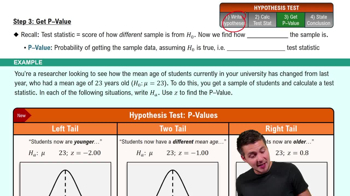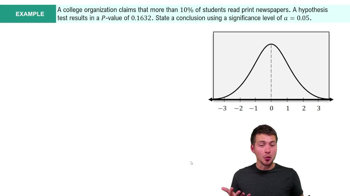Sampling Methods A student obtains a sample of responses to the question “Do you plan to take or have you taken a statistics course?” A second student obtains a sample of responses to the same question. The first student surveys only males at the same college, and the second student surveys only females at the same college. What is wrong with the samples? Can randomization be used to overcome the flaws of those samples?
Table of contents
- 1. Intro to Stats and Collecting Data1h 14m
- 2. Describing Data with Tables and Graphs1h 55m
- 3. Describing Data Numerically2h 5m
- 4. Probability2h 16m
- 5. Binomial Distribution & Discrete Random Variables3h 6m
- 6. Normal Distribution and Continuous Random Variables2h 11m
- 7. Sampling Distributions & Confidence Intervals: Mean3h 23m
- Sampling Distribution of the Sample Mean and Central Limit Theorem19m
- Distribution of Sample Mean - Excel23m
- Introduction to Confidence Intervals15m
- Confidence Intervals for Population Mean1h 18m
- Determining the Minimum Sample Size Required12m
- Finding Probabilities and T Critical Values - Excel28m
- Confidence Intervals for Population Means - Excel25m
- 8. Sampling Distributions & Confidence Intervals: Proportion1h 12m
- 9. Hypothesis Testing for One Sample3h 29m
- 10. Hypothesis Testing for Two Samples4h 50m
- Two Proportions1h 13m
- Two Proportions Hypothesis Test - Excel28m
- Two Means - Unknown, Unequal Variance1h 3m
- Two Means - Unknown Variances Hypothesis Test - Excel12m
- Two Means - Unknown, Equal Variance15m
- Two Means - Unknown, Equal Variances Hypothesis Test - Excel9m
- Two Means - Known Variance12m
- Two Means - Sigma Known Hypothesis Test - Excel21m
- Two Means - Matched Pairs (Dependent Samples)42m
- Matched Pairs Hypothesis Test - Excel12m
- 11. Correlation1h 6m
- 12. Regression1h 50m
- 13. Chi-Square Tests & Goodness of Fit1h 57m
- 14. ANOVA1h 57m
9. Hypothesis Testing for One Sample
Steps in Hypothesis Testing
Problem 14
Textbook Question
Testing Hypotheses
In Exercises 13–24, assume that a simple random sample has been selected and test the given claim. Unless specified by your instructor, use either the P-value method or the critical value method for testing hypotheses. Identify the null and alternative hypotheses, test statistic, P-value (or range of P-values), or critical value(s), and state the final conclusion that addresses the original claim.
Diastolic Blood Pressure Diastolic blood pressure levels of 60 mm Hg or lower are considered to be too low. For the 300 diastolic blood pressure levels listed in Data Set 1 “Body Data” from Appendix B, the mean is 70.75333 mm Hg and the standard deviation is 11.61618 mm Hg. Use a 0.01 significance level to test the claim that the sample is from a population with a mean greater than 60 mm Hg.
 Verified step by step guidance
Verified step by step guidance1
Step 1: Define the null hypothesis (H₀) and the alternative hypothesis (H₁). The null hypothesis represents the claim to be tested, and the alternative hypothesis represents the claim we are trying to support. Here, H₀: μ ≤ 60 mm Hg (the population mean is less than or equal to 60 mm Hg), and H₁: μ > 60 mm Hg (the population mean is greater than 60 mm Hg). This is a one-tailed test.
Step 2: Identify the test statistic to be used. Since the population standard deviation is unknown and the sample size is large (n = 300), we use the t-test for the sample mean. The formula for the test statistic is t = (x̄ - μ₀) / (s / √n), where x̄ is the sample mean, μ₀ is the hypothesized population mean, s is the sample standard deviation, and n is the sample size.
Step 3: Calculate the test statistic using the given values. Substitute x̄ = 70.75333, μ₀ = 60, s = 11.61618, and n = 300 into the formula t = (x̄ - μ₀) / (s / √n). Simplify the expression to find the value of the test statistic.
Step 4: Determine the critical value or P-value. For a one-tailed test with a significance level of α = 0.01, use a t-distribution table or statistical software to find the critical t-value corresponding to df = n - 1 = 299. Alternatively, calculate the P-value by finding the probability of obtaining a test statistic as extreme as the one calculated in Step 3.
Step 5: Compare the test statistic to the critical value or compare the P-value to the significance level. If the test statistic exceeds the critical value or if the P-value is less than α = 0.01, reject the null hypothesis. Otherwise, fail to reject the null hypothesis. State the conclusion in the context of the problem: whether there is sufficient evidence to support the claim that the population mean diastolic blood pressure is greater than 60 mm Hg.
 Verified video answer for a similar problem:
Verified video answer for a similar problem:This video solution was recommended by our tutors as helpful for the problem above
Video duration:
7mPlay a video:
Was this helpful?
Key Concepts
Here are the essential concepts you must grasp in order to answer the question correctly.
Hypothesis Testing
Hypothesis testing is a statistical method used to make inferences about population parameters based on sample data. It involves formulating two competing hypotheses: the null hypothesis (H0), which represents a statement of no effect or no difference, and the alternative hypothesis (H1), which indicates the presence of an effect or difference. The goal is to determine whether there is enough evidence in the sample data to reject the null hypothesis in favor of the alternative.
Recommended video:
Guided course

Step 1: Write Hypotheses
P-value
The P-value is a measure that helps determine the strength of the evidence against the null hypothesis. It represents the probability of obtaining a test statistic at least as extreme as the one observed, assuming that the null hypothesis is true. A smaller P-value indicates stronger evidence against the null hypothesis, and if the P-value is less than the significance level (e.g., 0.01), the null hypothesis is rejected.
Recommended video:
Guided course

Step 3: Get P-Value
Significance Level
The significance level, denoted as alpha (α), is a threshold set by the researcher before conducting a hypothesis test. It defines the probability of making a Type I error, which occurs when the null hypothesis is incorrectly rejected. Common significance levels are 0.05, 0.01, and 0.10. In this context, a significance level of 0.01 means that there is a 1% risk of concluding that a difference exists when there is none.
Recommended video:
Guided course

Step 4: State Conclusion Example 4

 6:21m
6:21mWatch next
Master Step 1: Write Hypotheses with a bite sized video explanation from Patrick
Start learningRelated Videos
Related Practice
Textbook Question
